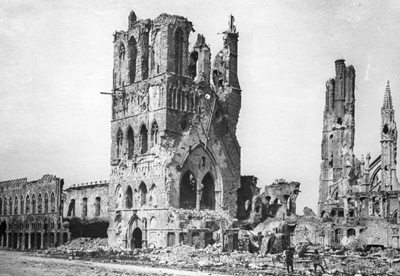The German invasion in August 1914 led to the conquest of almost all of Belgium. The only exception was the area around the town of Ypres, where a desperate British, French and Belgian defence during October and November had resulted in the German advance being stopped. This was the First Battle of Ypres. Afterwards both sides dug in and the front lines became trenches.
The Ypres Salient

The British positions around Ypres were surrounded on three sides by the Germans. This arrangement, known as a Salient, gave them an obvious starting point for an attack to recapture Belgium, but also left them vulnerable to being cut off by a German attack.
Further German attacks in April and May 1915 (the Second Battle of Ypres) reduced the Salient in size and led to them capturing high ground overlooking British positions. This would make preparations for any attack obvious to the Germans, allowing them to deploy artillery and reserves to defeat it.
In June 1917 the Battle of Messines saw the British capture some of this high ground. By then the Salient had acquired a reputation as a particularly harsh and dangerous section of the Western Front, even when there weren’t major battles taking place.
Third Ypres
The Third Battle of Ypres was to be a British attack. The ultimate aim was to disrupt German communications by capturing the railway junction at Roulers, and to prevent German submarines from using Belgian ports by recapturing the Channel coast. It was also hoped that if these objectives couldn’t be met, even a limited success would improve the British defensive positions.
The British Government was increasingly concerned about the level of casualties the Army was sustaining on the Western Front. They wanted to see a decisive battle that could bring the war to an end, although they weren’t convinced that an attack around Ypres was the best way to do this. However the attack was approved, on the understanding that it should not lead to ‘protracted, costly and indecisive operations.’
Field Marshal Haig, the commander of British forces in France, assigned the battle to Fifth Army, led by General Hubert Gough. Haig gave Gough contradictory signals about his aims. He hoped for a rapid breakthrough but realised that a slower, step by step battle was the more realistic prospect.
Gough’s Plan

It appears that Gough didn’t appreciate Haig’s true intent and made ambitious plans. The first stage would be to take Pilkem Ridge and the Gheluvelt Plateau, followed by the capture of Passchendaele Ridge, the high ground which dominated the Salient. Fifth Army would then advance north east to Roulers whilst other units carried out an amphibious landing on the coast. After they had linked up these forces would push on towards the Dutch border. Further south Second Army would advance on Menin, eliminating the southern edge of the Salient.
If it worked, this plan could lead to spectacular results. However it relied on achieving early success in the attack on ground that favoured the defence. Previous offensives hadn’t been anything like as successful, but had resulted in heavy casualties. In order to achieve his aims, Gough set an extremely ambitious objective of a 6,000 yard advance for the first day. He hoped to capture Passchendaele Ridge by the fourth.
Gough’s plans went against Haig’s preferred approach to the battle. However, he didn’t overrule Gough, as he felt that the final decision should be left to ‘the man on the spot’.
After a 15 day preliminary bombardment, firing 4 ½ million shells, the attack began on the 31st July. We take a look at the battle and the controversies surrounding it in The Battle of Passchendaele – Into Battle. Later on we’ll also look more closely at the Tank Corps, as it reached what was probably its lowest ebb.





